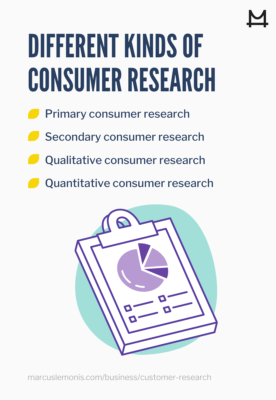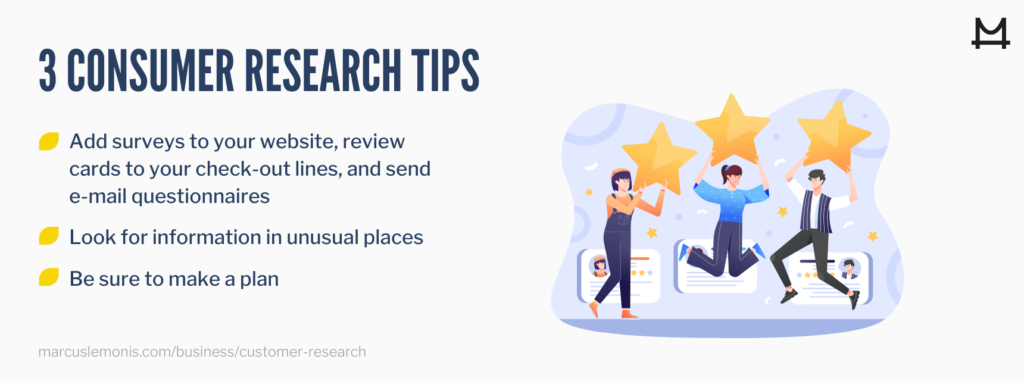
Big businesses spend a lot of time and money on consumer research. You can, too, but as a small business owner, it can be hard to know where to start. Some research firms run gigantic surveys with tens of thousands of participants, but that’s astronomically expensive and not realistic for an entrepreneur just starting out. What’s more, some of the terms used in this field can be confusing and complex. But, as Marcus says, “If you don’t know your numbers, you don’t know your business.” In this article, we’ll help you understand how to conduct consumer research, why it’s important, and give you examples of how it’s done. This will help your company market itself better, become more profitable, and build customer loyalty.
Here’s What Consumer Research Really Means
At its core, Consumer Research means finding out what your customers want and need from your company and its products. It’s also finding out what they believe, and it looks at how they act when they’re purchasing. The end goal is to take this information, look at all of the other data gathered, and then use it to tweak your business to better fit your clients’ needs. Marcus’s saying “People. Process. Product” is exemplified here. Listening to customers and building a process around that information will lead to a better product.

Here’s Why Consumer Research Is Important
Who doesn’t appreciate it when their opinions are valued? Your customers express their values, attitudes, and enthusiasm through their pocketbooks. From a management perspective, acting on customer research information will help find oversights and missteps, leading to customer retention. This is why Marcus stresses that the first step to success for entrepreneurs like you is to know your numbers.
In a big business, even a tiny improvement in sales or marketing can have a considerable impact. That’s why most corporations pay a lot of attention to their consumer research data. For example, Verizon became the first wireless company to let their customers keep their phone numbers after switching carriers in 2003. (Richtel, 2003). Initially, the company opposed that move, citing that it would cost hundreds of millions of dollars. They came to this decision after listening to customer complaints, and they gained $3.8 billion in revenue that year. (Verizon, 2004). As Marcus says, “You don’t have to be a genius to run a successful small business, but you better be smart enough to be willing to learn.”

Here’s How Consumer Research Can Help Your Business
It puts you in tune with your customers.
Consumer research does many things. It can make your advertisements more engaging. It can help you find new customers you may have overlooked. It can even hint toward industry trends before they’re widely known. But the most important thing it does is help you connect with your customers. Customers, for the most part, tell you what they want. All you have to do is ask the right questions.
It helps develop new products and services.
Marcus says, “If you don’t evolve, you will die.” New products and services require innovation, and consumer research data fuels innovation. In 2008, The LEGO Group, maker of children’s toys LEGO, found that only 10% of their user base was female. The company decided to remedy that situation and sent researchers out to do a four-year study of what girls wanted out of their toys. In 2012, LEGO Friends hit the shelves, and the company has grown 15% annually since its launch. (Lafrance, May 25).

It helps fine-tune your existing products and services.
Your customers can tell you where they would like to see improvements. Sometimes, though, consumers don’t know what they want. That’s why breakthrough innovations and product maintenance are different animals. Cell phone users didn’t ask Apple for the iPhone. The average customer likely didn’t know iPhone technology was possible, but Steve Jobs knew it would revolutionize the industry. Apple does listen to its customers regarding app updates, requests for higher-resolution cameras, and other features. Using the right information at the correct times can lead to product innovations and improvements.
The Different Kinds of Consumer Research
Primary Consumer Research
When you or someone from your company interacts directly with your customers, asking them questions or having them fill out a survey, that’s primary consumer research.

You can hire a firm to do primary research for you so long as it only targets your customers.
-
- Primary consumer research is a simple method to gain data. It can be less expensive than other options because you don’t have to hire an outside company to help. You attain focused, specific details about your company and its offerings, but it offers little information about industry trends.
- Online forms, mailers, phone surveys, and focus groups are all examples of primary consumer research.
Secondary Consumer Research
- Hiring an outside company to compile and consolidate customer data information for you is called secondary consumer research.

It’s cost-effective because you don’t have to conduct any research yourself. It tends to focus less on your specific customers than industry and market trends on the whole. You can compare your company to others, which will give you a better idea of where you are excelling and where you need help.
- Secondary consumer research measures customer attitudes and preferences better than primary research partly because it pulls from a larger group of participants. It’s not as good at focusing on your specific products because it tends to ask general questions that result in general ideas about your industry.
Because most outside research companies use data gathered nationwide, it presents a better picture of how your company will fare across the country instead of just in your town or city.

- Examples of secondary consumer research companies include Nielsen, IQVIA, Kantar, Gartner, IPSOS, and Dynata. Some of the specific data these companies compile includes purchasing trends, demographics, and market confidence.
Qualitative Consumer Research
- The part of the word qualitative you should focus on is qual, as in quality. It focuses on how people feel about your products, and it asks them to focus on their quality.
It can also focus on how they perceive the quality of your customer service. Or the quality of your products’ perception. Qualitative consumer research is used in combination with primary or secondary research, and it delivers a specific kind of information.

-
- Qualitative consumer research is how you get information that relates to your brand. It uses words such as like, enjoys, love, prefer, dislike, and better. Asking a customer why they prefer product A compared to product B is an example. It’s not about how many people like it; it’s about how your customers feel.
- Qualitative consumer research is useful for areas that don’t lend themselves to more rigorous research methods. This is particularly useful for sensitive questions that people may not want to answer because it doesn’t put people into a yes-or-no situation.
It asks them to explain their answers. Questions like, “What is it you enjoy about product X,” and “What inspired you to purchase service Y?” are examples of qualitative consumer research.

Quantitative Consumer Research
-
- The other way you can perform your primary or secondary research is with quantitative consumer research. Focus on the quant portion of the word quantitative, like quantity. This form of research is all about the numbers. It can provide you with statistics based on shopping habits by gender, the exact amount of time e-retail shoppers spend on your website, or how many people are familiar with your store.
- Quantitative consumer research is useful for business owners who need mathematical answers to specific questions.
If your customers are overwhelmingly male, you can find out the exact percentage of male shoppers. However, you won’t be able to tell why you have so many male customers through quantitative research. You would need qualitative research to answer that.
- Examples of quantitative consumer research methods include surveys and questionnaires, and polls.


3 Consumer Research Tips For Entrepreneurs
Add surveys to your website, review cards to your check-out lines, and send e-mail questionnaires.
You can gauge satisfaction and see demographic splits just by asking your customers to tell you about themselves. You may have to incentivize customers to participate, but think of the value you gain by having usable data. Be sure to ask a mix of quantitative and qualitative questions to get the best responses.
Look for information in unusual places.
Websites like Quora, Twitter, and Reddit have users asking questions. By combing over questions on those sites, you can harvest important information. Plus, everything is indexed and organized for you. If you run a bicycle shop, there are countless threads, groups, and subreddits dedicated to bicycle enthusiasts. Those users are potential customers, and their inspirations, questions, and suggestions are valuable. As a bonus, this form of research only requires your time.
Be sure to make a plan.
Gathering a ton of information is only helpful if you know what you’re looking for.
Before hiring a consultant or launching your own customer research scheme, ask yourself the following questions.
- What are you hoping to accomplish through this research?
- Who are you targeting?
- Will you be able to measure growth if the data you collect leads you to make changes?
- How is the information you collect going to lead you?
- Are you willing to change your products if necessary?


The Right Questions For The Right Customers At The Right Time
Market research is just as crucial for small businesses as huge corporations. You never know when a slight increase in your customer base or launching a new product will boost your company into the stratosphere. Through consumer research, you’ll have a better idea of where to start those processes. If you give enough thought to asking the right questions, then you’ll get the answers you’re looking for. As Marcus says, “At the end of the day, the numbers don’t lie.” Gather the right data, and your business will be all the better for it.
- Is it time for your business to conduct consumer research?
- Which consumer research type best fits your business?
Doheny, Julia. (n.d.). Using Market Research For Product Development. https://www.b2binternational.com/publications/product-development-research/#_ftn1
Lafrance, Adrienne. (2016, May 25). How to Play Like a Girl. https://www.theatlantic.com/entertainment/archive/2016/05/legos/484115/
Richtel, Matt. (2003, Jun. 25). TECHNOLOGY; In a Reversal, Verizon Backs Rule to Keep Cell Numbers. https://www.nytimes.com/2003/06/25/business/technology-in-a-reversal-verizon-backs-rule-to-keep-cell-numbers.html
Verizon Communications. (2004). Verizon Communications 2004 Annual Report. https://www.annualreports.com/HostedData/AnnualReportArchive/v/NYSE_VZ_2004.pdf





